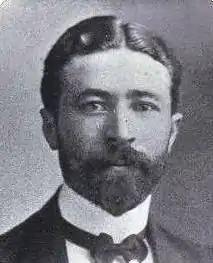
Charles Vincent Paterno (born Canio Paternò, August 4, 1878 – May 30, 1946) was an Italian-born American real estate developer. He was called the "Napoleon of the Manhattan Skyscraper Builders".[1]
Life and career
Born in Castelmezzano, in the Italian region of Basilicata, to Giovanni Paternò, a real estate businessman, and Carolina Trivigno, Paterno emigrated to the United States due to financial problems caused by an earthquake which destroyed a construction project that his father was involved with. He graduated from Cornell Medical School in 1899, with the intention of becoming a doctor of medicine[2] but he never practiced the profession.[3] After his father's death, Paterno and his brother Joseph took over the family real estate business.[4][5] By 1918, the Paternos owned 75 buildings housing about 28,000 people.[6]
The Paterno name is connected to the construction and the development of a number of modern, luxurious apartment buildings in the Upper East Side, Morningside Heights, and Washington Heights neighborhoods of Manhattan in New York City, including:
- The Colosseum (1909–1910)
- The Paterno (1909–1910)[7]
- Hudson View Gardens (1923–25)
- 825 Fifth Avenue (1926–1927)
- Castle Village (1938–1939)
Paterno died at the Westchester Country Club in Harrison, New York, on May 30, 1946.[3] He is memorialized by the Paterno Trivium at the intersection of Cabrini Boulevard, West 187th Street, and Pinehurst Avenue in the Hudson Heights subsection of Washington Heights.[8]
Paterno Castle
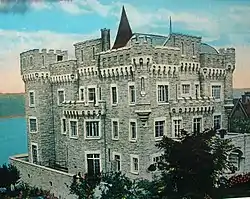
The Paterno Castle, was an early 20th century Neo-Gothic four-story 35-room castle shaped mansion located in New York City, where Charles Paterno lived, in what is now a apartment complex.
The completed castle survived barely two decades. Paterno later moved from the castle to Greenwich, Connecticut,[9] and in 1938 he decided to demolish the castle and most of the surrounding estate to erect the "Castle Village" complex of co-operative apartments.[10] The area was becoming increasingly residential, and The New York Times quoted Paterno as saying that "the many improvements in that part of the city...had led to a strong residential movement in that area with a definite demand for the finer type of garden type apartments."[4]
Some remnants of the estate can still be seen to this day.
Gallery
_cropped.jpg.webp) The Colosseum apartment building in 1910
The Colosseum apartment building in 1910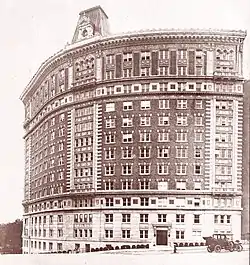 The Paterno in 1910
The Paterno in 1910 Hudson View Gardens as seen from Bennett Park
Hudson View Gardens as seen from Bennett Park A building of the Castle Village complex
A building of the Castle Village complex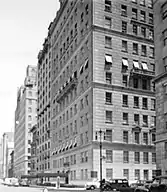 825 Fifth Avenue, c.1939-1941
825 Fifth Avenue, c.1939-1941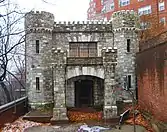 A remnant of the Paterno estate, now a utility building for Castle Village
A remnant of the Paterno estate, now a utility building for Castle Village The retaining wall from the estate is still used for Castle Village, seen behind it.
The retaining wall from the estate is still used for Castle Village, seen behind it.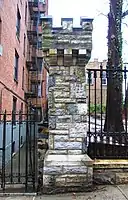 A stone pillar remnant from the estate
A stone pillar remnant from the estate The "Pumpkin House", the former guest house of the Paterno estate as seen from the Hudson River Greenway.
The "Pumpkin House", the former guest house of the Paterno estate as seen from the Hudson River Greenway.
References
Notes
- ↑ Italian Americana, Volume 8, 1986, p.10
- ↑ Cornell University staff (1900). "Thirty-First Annual Commencement: Doctors of Medicine". The Register of Cornell University. Ithaca, New York: Andrus & Church. p. 435.
- 1 2 Staff (May 31, 1946). "Charles V. Paterno (obituary)". The Brooklyn Daily Eagle. p. 11. Retrieved January 9, 2016.
- 1 2 Miller, Tom (July 16, 2012) "The Lost 1909 Paterno Castle – 185th Street and Riverside Drive" Daytonian in Manhattan
- ↑ "Joseph Paterno ; Dr. Charles Paterno". NYPL Digital Collections. Retrieved 2020-11-21.
- ↑ Walsh, Kevin (December 22, 2000) "Postcards from the Edge of Town" Forgotten NY
- ↑ Gray, Christopher (August 15, 1999). "The Colosseum and the Paterno, 116th Street and Riverside Drive; At Curves in the Road, 2 Unusually Shaped Buildings". The New York Times. Retrieved 2008-02-07.
- ↑ Paterno Trivium, New York City Parks and Recreation Department
- ↑ Staff (January 22, 2010) "Patrno's Castle" My Inwood
- ↑ "Demolishing A Castle In New York 1938" (video) British Pathé
Further reading
- "Charles V. Paterno: His Castle Ruled Washington Heights" Keith York City
External links
 Media related to Charles Paterno at Wikimedia Commons
Media related to Charles Paterno at Wikimedia Commons